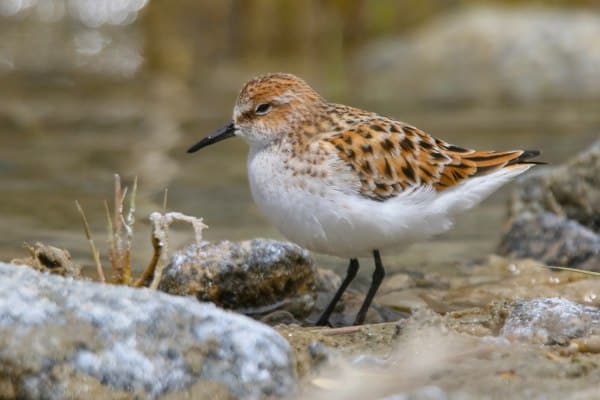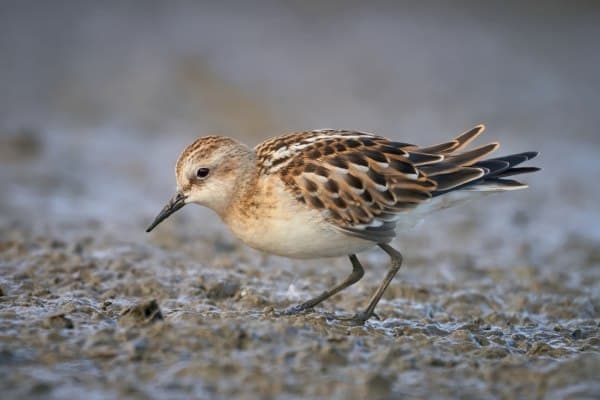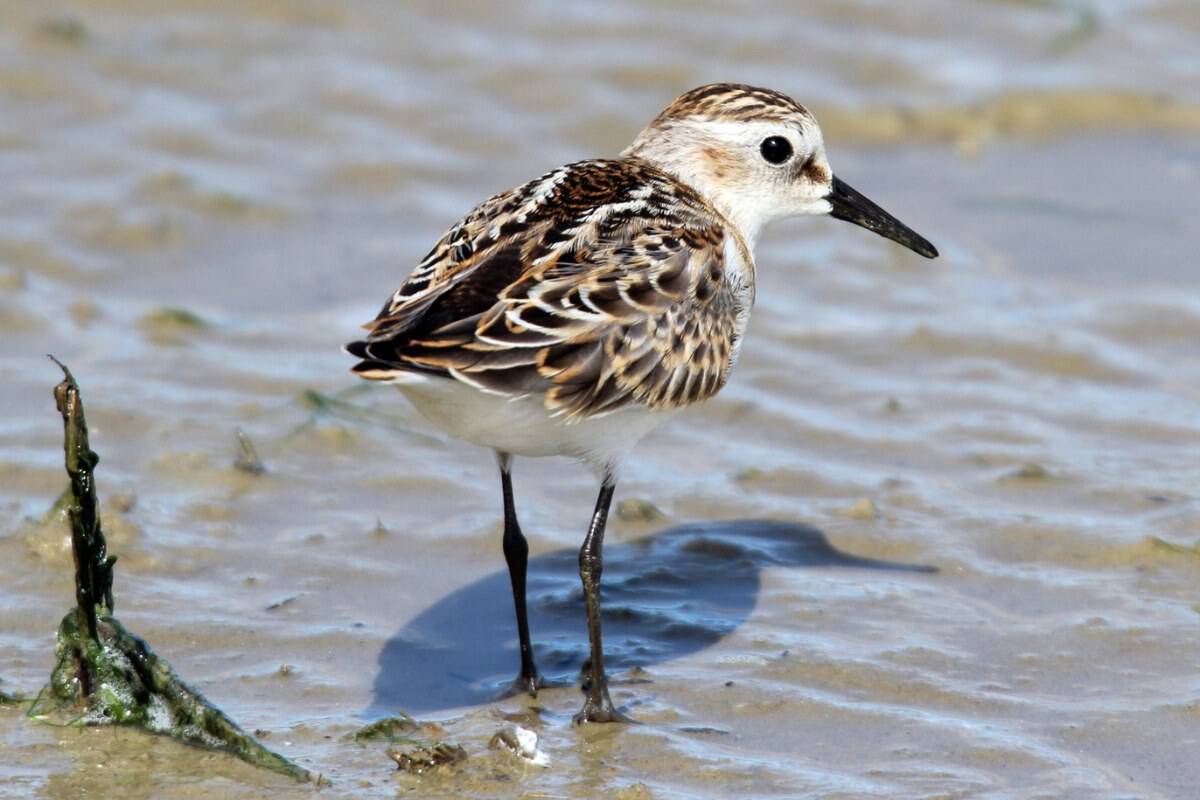Common Name: Little Stint
Scientific Name: (Calidris minuta)| Size | Diet | Range in Hawaii | Status in Hawaii |
|---|---|---|---|
| 5 in. - 6 in. | crustaceans, insects, mollusks | O'ahu | Least Concern |
The Little Stint, also known as Calidris minuta, is a small shorebird species that is native to the Arctic regions of Europe and Asia. While the species is not native to Hawaii, it has been known to make occasional appearances on the islands as a non-breeding visitor and vagrant. With its small size and unique foraging behavior, the Little Stint is a fascinating bird species that has captured the attention of birdwatchers and avian enthusiasts around the world.
In this article, we will explore the world of the Little Stint, its unique characteristics, and its occasional presence in Hawaii.
Little Stint
Appearance

The Little Stint is a delicate and captivating shorebird that enchants with its subtle beauty. With an average size of about 5 to 6 inches (13 to 15 centimeters), it’s a petite marvel that defies its small stature. During its breeding plumage, it showcases a beautifully intricate array of colors—soft chestnut on its back, a striking black patch on its belly, and delicate streaks of white on its chest.
Diet
Along its migratory journey, this petite shorebird embarks on a culinary adventure that revolves around intertidal delicacies. With its dainty yet specialized bill, it masterfully probes the mud and sand for a diverse menu of invertebrates. From tiny crustaceans to delicate insects and mollusks, the Little Stint navigates the ever-changing buffet of the intertidal zone, proving that size is no barrier to gastronomic exploration.
Nesting
With meticulous precision, the Little Stint weaves together nature’s bounty – feathers, grasses, and delicate tendrils – into a snug cup, cradling the future generation. Each piece is strategically chosen, as if the bird itself is an artist, meticulously selecting colors and textures to craft its masterpiece. Amidst the tranquil wetlands, the nest becomes a sanctuary, a fleeting sanctuary of fragility and strength.
As the sun paints the sky with its golden hues, the Little Stint takes on the role of a vigilant guardian, perched nearby, ever-watchful. Their commitment to their nest is awe-inspiring, a testament to the indomitable spirit of life.
Intriguingly, the Little Stint’s nesting practices mirror its own character—compact, efficient, and yet full of vibrancy. As the eggs are laid and incubation begins, the nest becomes a hub of life, a symbol of resilience in the face of ever-changing wetland dynamics.
Behavior

These petite birds are known for their boundless energy, flitting about the water’s edge with an infectious enthusiasm. With lightning-fast reflexes, they navigate the shifting sands and shallows, probing the mud for delectable morsels hidden beneath. Their dainty bills become precision instruments, striking with remarkable accuracy to capture small invertebrates and aquatic insects.
But it’s not just their feeding that captures attention; it’s their social interactions that truly enchant. Little Stints are incredibly sociable beings, congregating in flocks that seem to ebb and flow like living tides. Their synchronized movements, akin to a ballet troupe, create an ever-shifting tableau of harmony and unity.
During the breeding season, the Little Stint’s behavior takes on a more dramatic flair. Males engage in a captivating courtship ritual, showcasing their vibrant breeding plumage and performing aerial displays that are nothing short of breathtaking. These displays not only serve to attract potential mates but also to demonstrate their prowess in the art of survival.
Perhaps what makes the behavior of the Little Stint most remarkable is its ability to navigate vast distances during migration. These small birds embark on epic journeys, covering thousands of miles between their breeding and wintering grounds. Their determination and resilience in the face of such challenges stand as a testament to the wonders of avian behavior.
Habitat

The Little Stint thrives in the shifting realm where water meets land. These agile shorebirds navigate coastal wetlands, mudflats, and shallow pools with finesse. Whether blending into autumn marshes or the azure coast, the Little Stint’s habitat is a dynamic canvas of survival and beauty.
Range
Little Stints, normally residents of Arctic Eurasia, occasionally make their way to the Hawaiian Islands as vagrants. These petite shorebirds, with only a handful of confirmed records, have been observed on islands like Kure in the Northwestern Hawaiian Islands, O’ahu, and Midway.
Conservation Status
The Little Stint dances on the edge of conservation concern, a delicate performer in the grand theater of biodiversity. As a species with a “Least Concern” status, according to the International Union for Conservation of Nature (IUCN), the Little Stint appears to have secured a relatively stable spot in the avian ensemble.
Interesting Facts
1. Masters of adaptation
These birds are well-equipped to deal with varying conditions. From the harsh Arctic cold to tropical coastal habitats, Little Stints have developed remarkable adaptability to different environments.
2. Migration maestros
During the Arctic summer, these birds make their homes in the high latitudes of Siberia and northern Europe. Their breeding grounds provide them a safe haven to raise their young and take advantage of the brief northern summer.
3. Mimicry masters
These birds have an uncanny ability to mimic the calls of other shorebird species. This mimicry likely helps them integrate into mixed flocks, gaining safety in numbers during their migrations.
4. Energetic eaters
To sustain their marathon journeys, Little Stints eat almost constantly while they’re feeding. Their high-energy diet is essential for maintaining their stamina during long flights.
5. Juvenile disguise
Juvenile Little Stints sport a more subdued and mottled plumage, providing them with better camouflage against their surroundings. This helps protect them from predators as they grow.
Frequently Asked Questions
1. How do Little Stints navigate during migration?
The exact mechanisms of their navigation are still being studied, but it’s believed that Little Stints use a combination of celestial cues, landmarks, and Earth’s magnetic fields to find their way during migration.
2. How long do Little Stints live?
Little Stints have an average lifespan of about 2 to 4 years in the wild. However, some individuals may live longer, especially if they manage to survive the challenges of migration and find suitable habitats throughout their journeys.
3. How many eggs does a Little Stint typically lay?
Little Stints usually lay a clutch of 3 to 5 eggs. Both the male and female take turns incubating the eggs, and after hatching, they also share the responsibilities of feeding and caring for the chicks.
4. Are Little Stints monogamous during the breeding season?
Yes, Little Stints are generally monogamous during the breeding season. They form pairs that work together to incubate eggs and raise their chicks.
5. Can Little Stints drink saltwater like some other shorebirds?
No, unlike some other shorebirds, Little Stints do not possess the specialized salt glands that allow them to drink saltwater. They need to find sources of freshwater for drinking.




